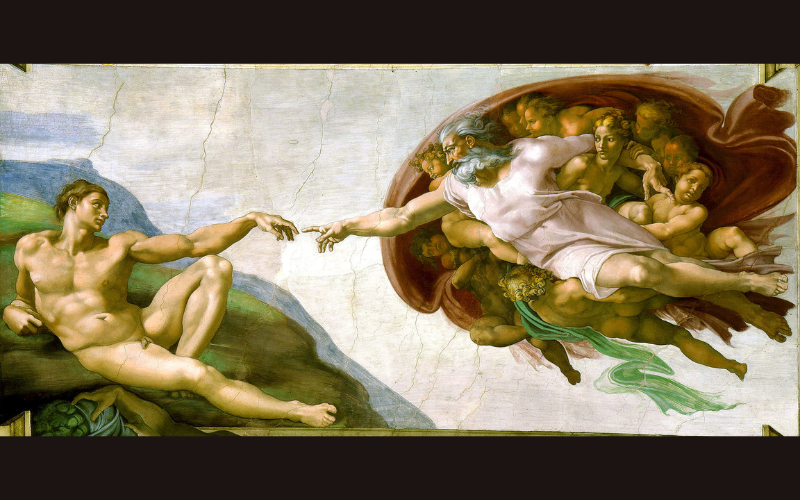When Michelangelo completed the Sistine Chapel ceiling between 1508 and 1512, he created not just an artistic marvel but a work that contained hidden anatomical drawings that have mystified Vatican visitors for centuries. Beyond its divine beauty and biblical narratives lies a tantalizing theory that Michelangelo incorporated hidden anatomical drawings into his frescoes, blending science with spirituality. Could this masterpiece be more than what meets the eye—a hidden tribute to the human body concealed within holy imagery?
Michelangelo: The Artist Who Knew the Human Body
To grasp the possibility of hidden anatomy, one must first understand Michelangelo’s deep connection with the human form. As a young artist in Florence, he studied cadavers, dissecting them and learning the structure of muscles, bones, and organs. This intimate knowledge of anatomy gave amazing life to his sculptures, from the powerful tension in David to the delicate sorrow displayed in Pietà.
By the time Michelangelo stood atop the scaffolding of the Sistine Chapel, his mastery of anatomy was unparalleled. Yet, some theorists suggest that his fascination with the human body extended beyond artistic precision—into the realm of abstract scientific imagery, subtly woven into the divine frescoes.
Theories of Hidden Anatomical Drawings
The Creation of Adam: A Brain Hidden in Plain Sight?
The Creation of Adam is among the most celebrated sections of the Sistine Chapel ceiling, showing God reaching out to spark life into Adam. But in 1990, Dr. Frank Meshberger proposed a startling theory: the shape encircling God and the angels is a perfect anatomical representation of the human brain.
The folds of God’s robes, the outstretched arms of the figures, and even their arrangement align with the cerebrum, brainstem, and optic nerves.
Could this depiction symbolize divine intellect, with Michelangelo suggesting humanity’s connection to God lies in knowledge and thought? Or was it a hidden homage to the brilliance of the human mind, veiled in a sacred imagery?
The Brainstem in The Separation of Light and Darkness
The fresco The Separation of Light from Darkness captures God dividing the light from the darkness, a portrayal of divine power. Yet, some researchers have noted peculiar details: the shadows and folds in God’s neck bear a striking resemblance to the human brainstem.
If intentional, this detail might reflect Michelangelo’s belief that the act of creation itself is rooted in intellect and understanding.
Could this be another instance of the artist embedding anatomy into the divine? Or is it mere coincidence that such a resemblance exists?
Heart and Lungs in The Prophet Jonah
The figure of The Prophet Jonah introduces another layer of anatomical intrigue. Scholars have observed that Jonah’s contorted posture and the surrounding elements mirror the structure of the human heart and lungs.
The whale arching above Jonah’s head resembles the aortic arch, while his splayed limbs echo pulmonary anatomy.
Could Michelangelo have intended this subtle yet deliberate nod to human physiology? And if so, why?
Why Hide Anatomical Drawings in a Sacred Space?
The question remains: why would Michelangelo risk embedding scientific imagery in one of the holiest commissions of his time?
One theory is that Michelangelo sought to harmonize art, science, and faith, expressing his belief that understanding the human body was a way of understanding God’s creation. In his frescoes, science and divinity could coexist, forming a bridge between the physical and the spiritual.
Yet another theory points to Michelangelo’s complicated relationship with the Catholic Church. Frustrated with religious authority, he may have hidden anatomical drawings as a form of subtle rebellion—a quiet assertion of his intellectual independence within a space governed by ecclesiastical power.
A Lingering Debate
While the notion of hidden anatomy has captivated many, it remains a subject of heated debate. Critics argue that the perceived anatomical references are coincidental, shaped by modern interpretations rather than Michelangelo’s intent. Others insist that these elements reveal a deliberate interplay between his artistic vision and scientific knowledge.
Regardless of the debate, the possibility of hidden anatomical drawings adds a layer of intrigue to an already iconic masterpiece. It challenges viewers to look beyond the obvious grandeur of the frescoes, inviting them to search for secrets concealed within the details.
The Enduring Mysteries of the Sistine Chapel
Whether or not Michelangelo intended to embed anatomical drawings, the idea underscores the complexity of his genius. The Sistine Chapel ceiling is a marvel of artistic mastery, but the possibility of hidden meanings elevates it into a realm of eternal mystery.
For centuries, the frescoes have been admired for their beauty, but the prospect of secret messages reminds us that art often carries layers waiting to be uncovered. Whether these hidden details are a tribute to anatomy, an act of rebellion, or simply an artist’s flourish, one truth remains: the Sistine Chapel continues to captivate, inspire, and provoke.





 “Yesteryear’s Ruin” captures the essence of human resilience in the face of unimaginable loss. Through a narrative that weaves together love, despair, and the quest for redemption, this historical psychological thriller invites readers into a world where the past is not merely a memory, but a realm that may hold the key to our deepest desires and darkest fears.
“Yesteryear’s Ruin” captures the essence of human resilience in the face of unimaginable loss. Through a narrative that weaves together love, despair, and the quest for redemption, this historical psychological thriller invites readers into a world where the past is not merely a memory, but a realm that may hold the key to our deepest desires and darkest fears.